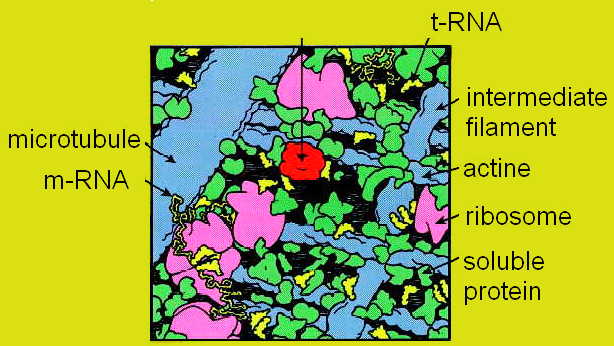Macromolecular crowding
In contrast to the dilute solutions in which classical enzymology studies are conducted, the interior of cells represents a very dense and crowded environment. Although the concentration of each defined molecular species is usually low (sub micromolar range), the combined density of "background" macromolecular components can reach very high values (200-300 mg protein/ml in the cytoplasm!).
 In addition, cells contain a profusion of surfaces, like membranes and cytoskeletal fibres, which not only occupy a significant fraction of the cellular volume, but also provide a substrate upon which non-specific adsorption occurs. This leaves a very limited space to water, the major solvent, which gets organized into a few solvation layers, in contrast to the more familiar "bulk water" in dilute solution. In extreme cases, like in the matrix of mitochondria, macromolecules are said to exist and function in a quasi-crystalline state. This situation may represent a prerequisite for the self-organization characteristic of all living systems; thermodynamically, the process is entropy-driven due to water exclusion, similarly to protein folding.
In addition, cells contain a profusion of surfaces, like membranes and cytoskeletal fibres, which not only occupy a significant fraction of the cellular volume, but also provide a substrate upon which non-specific adsorption occurs. This leaves a very limited space to water, the major solvent, which gets organized into a few solvation layers, in contrast to the more familiar "bulk water" in dilute solution. In extreme cases, like in the matrix of mitochondria, macromolecules are said to exist and function in a quasi-crystalline state. This situation may represent a prerequisite for the self-organization characteristic of all living systems; thermodynamically, the process is entropy-driven due to water exclusion, similarly to protein folding.
A crowded physico-chemical environment bears several fundamental implications for the structure, function and evolution of cellular systems, and their experimental study:
- the effective concentration of solutes (or thermodynamic activity) is increased in cells, typically by one or two orders of magnitude, relative to dilute solutions.
This promotes macromolecular association, and modulates further organization;
- on the other hand, the increased tortuosity of the aqueous paths left for molecular motion should limit the rate of encounter of two defined species (diffusion control);
- the combined effects should yield a biphasic (peak) dependence of bimolecular association on a crowding parameter (e.g., background molecules concentration or their fractional volume occupancy);
- on the evolutionary scale (origin of life not included), every organism is constantly struggling through molecular evolution to reach the right balance between both effects, and/or maintain it (e.g., control of cell volume).
Finally, extreme caution should be exerted in the extrapolation of experimental results (acquired in dilute solutions) to function in the intact cell.
last update, Apr 2003 - Claude Aflalo - suggestions are welcome...
 In addition, cells contain a profusion of surfaces, like membranes and cytoskeletal fibres, which not only occupy a significant fraction of the cellular volume, but also provide a substrate upon which non-specific adsorption occurs. This leaves a very limited space to water, the major solvent, which gets organized into a few solvation layers, in contrast to the more familiar "bulk water" in dilute solution. In extreme cases, like in the matrix of mitochondria, macromolecules are said to exist and function in a quasi-crystalline state. This situation may represent a prerequisite for the self-organization characteristic of all living systems; thermodynamically, the process is entropy-driven due to water exclusion, similarly to protein folding.
In addition, cells contain a profusion of surfaces, like membranes and cytoskeletal fibres, which not only occupy a significant fraction of the cellular volume, but also provide a substrate upon which non-specific adsorption occurs. This leaves a very limited space to water, the major solvent, which gets organized into a few solvation layers, in contrast to the more familiar "bulk water" in dilute solution. In extreme cases, like in the matrix of mitochondria, macromolecules are said to exist and function in a quasi-crystalline state. This situation may represent a prerequisite for the self-organization characteristic of all living systems; thermodynamically, the process is entropy-driven due to water exclusion, similarly to protein folding.